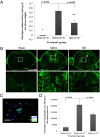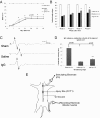Immunoglobulin G (IgG) attenuates neuroinflammation and improves neurobehavioral recovery after cervical spinal cord injury
- PMID: 22998664
- PMCID: PMC3503837
- DOI: 10.1186/1742-2094-9-224
Immunoglobulin G (IgG) attenuates neuroinflammation and improves neurobehavioral recovery after cervical spinal cord injury
Abstract
Background: Evidence suggests that the inflammatory events in the acute phase of spinal cord injury (SCI) exacerbate the initial trauma to the cord leading to poor functional recovery. As a result, minimizing the detrimental aspects of the inflammatory response after SCI is a promising treatment strategy. In this regard, immunoglobulin G (IgG) from pooled human serum is a promising treatment candidate. Due to its putative, though poorly characterized immuno-modulatory effects, IgG has been used clinically to treat neuroinflammatory disorders such as Guillain-Barré syndrome, but its effects in neurotrauma remain largely unexplored.
Methods: This study examines the potential neuroprotective effects of IgG in a well-characterized cervical model of SCI. Female Wistar rats were subject to moderate-severe clip compression injury at the C7-T1 level. IgG (0.4 g/kg) or saline was injected intravenously to randomly selected animals at 15 min post SCI. At several time points post SCI, biochemical assays, histology and immunohistochemistry analyses, and neurobehavioral assessments were used to examine the neuroprotective effects of IgG at the molecular, cellular, and neurobehavioral levels.
Results: We found that intravenous treatment of IgG following acute clip-compression SCI at C7-T1 significantly reduced two important inflammatory cytokines: interleukin (IL)-1β and IL-6. This early reduction in pro-inflammatory signaling was associated with significant reductions in neutrophils in the spinal cord and reductions in the expression of myeloperoxidase and matrix metalloproteinase-9 in the injured spinal cord at 24 h after SCI. These beneficial effects of IgG were associated with enhanced tissue preservation, improved neurobehavioral recovery as measured by the BBB and inclined plane tests, and enhanced electrophysiological evidence of central axonal conduction as determined by motor-evoked potentials.
Conclusion: The findings from this study indicate that IgG is a novel immuno-modulatory therapy which shows promise as a potential treatment for SCI.
Figures






Similar articles
-
The effects of human immunoglobulin G on enhancing tissue protection and neurobehavioral recovery after traumatic cervical spinal cord injury are mediated through the neurovascular unit.J Neuroinflammation. 2019 Jul 9;16(1):141. doi: 10.1186/s12974-019-1518-0. J Neuroinflammation. 2019. PMID: 31288834 Free PMC article.
-
Delayed administration of high dose human immunoglobulin G enhances recovery after traumatic cervical spinal cord injury by modulation of neuroinflammation and protection of the blood spinal cord barrier.Neurobiol Dis. 2021 Jan;148:105187. doi: 10.1016/j.nbd.2020.105187. Epub 2020 Nov 26. Neurobiol Dis. 2021. PMID: 33249350
-
Effect of 17beta-estradiol on functional outcome, release of cytokines, astrocyte reactivity and inflammatory spreading after spinal cord injury in male rats.Brain Res. 2008 Apr 8;1203:177-88. doi: 10.1016/j.brainres.2008.01.091. Epub 2008 Feb 13. Brain Res. 2008. PMID: 18316064
-
Immunoglobulin G: a potential treatment to attenuate neuroinflammation following spinal cord injury.J Clin Immunol. 2010 May;30 Suppl 1(Suppl 1):S109-12. doi: 10.1007/s10875-010-9404-7. J Clin Immunol. 2010. PMID: 20437085 Free PMC article. Review.
-
Treatment of spinal cord injury with intravenous immunoglobulin G: preliminary evidence and future perspectives.J Clin Immunol. 2014 Jul;34 Suppl 1(Suppl 1):S132-8. doi: 10.1007/s10875-014-0021-8. Epub 2014 Apr 11. J Clin Immunol. 2014. PMID: 24722853 Free PMC article. Review.
Cited by
-
Inflammogenesis of Secondary Spinal Cord Injury.Front Cell Neurosci. 2016 Apr 13;10:98. doi: 10.3389/fncel.2016.00098. eCollection 2016. Front Cell Neurosci. 2016. PMID: 27147970 Free PMC article. Review.
-
IgM Immunoglobulin Influences Recovery after Cervical Spinal Cord Injury by Modulating the IgG Autoantibody Response.eNeuro. 2021 Sep 9;8(5):ENEURO.0491-19.2021. doi: 10.1523/ENEURO.0491-19.2021. Print 2021 Sep-Oct. eNeuro. 2021. PMID: 34413082 Free PMC article.
-
The paradox of chronic neuroinflammation, systemic immune suppression, autoimmunity after traumatic chronic spinal cord injury.Exp Neurol. 2014 Aug;258:121-129. doi: 10.1016/j.expneurol.2014.04.023. Exp Neurol. 2014. PMID: 25017893 Free PMC article. Review.
-
IVIg attenuates complement and improves spinal cord injury outcomes in mice.Ann Clin Transl Neurol. 2016 May 25;3(7):495-511. doi: 10.1002/acn3.318. eCollection 2016 Jul. Ann Clin Transl Neurol. 2016. PMID: 27386499 Free PMC article.
-
Regeneration of Spinal Cord Connectivity Through Stem Cell Transplantation and Biomaterial Scaffolds.Front Cell Neurosci. 2019 Jun 6;13:248. doi: 10.3389/fncel.2019.00248. eCollection 2019. Front Cell Neurosci. 2019. PMID: 31244609 Free PMC article. Review.
References
-
- Kwon BK, Sekhon LH, Fehlings MG. Emerging repair, regeneration, and translational research advances for spinal cord injury. Spine. 2010;Suppl. 1:S263–S270. - PubMed
-
- Blight AR. Delayed demyelination, macrophage invasion: a candidate for “secondary” cell damage in spinal cord injury. Cent Nerv Syst Trauma. 1985;2:299–315. - PubMed
-
- Young W. Secondary injury mechanisms in acute spinal cord injury. J Emerg Med. 1993;11:13–22. - PubMed
Publication types
MeSH terms
Substances
LinkOut - more resources
Full Text Sources
Medical
Research Materials
Miscellaneous

